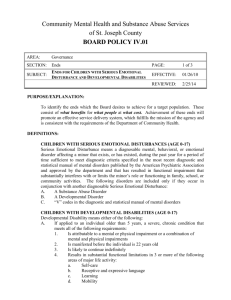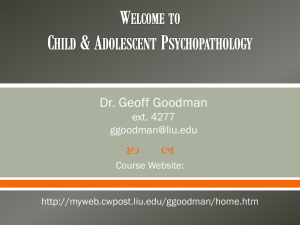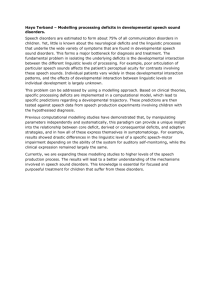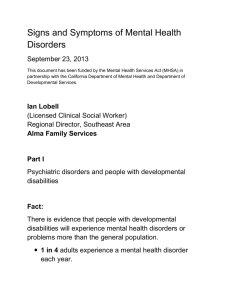Child & Adolescent Psychiatry Goals and Objectives
advertisement
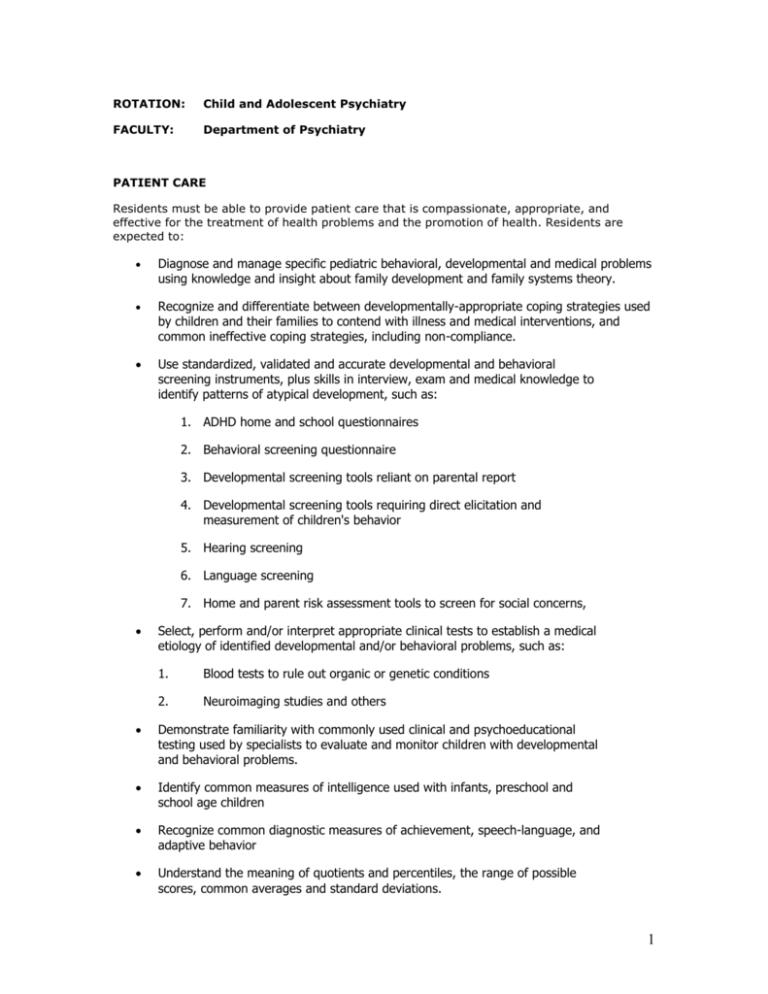
ROTATION: Child and Adolescent Psychiatry FACULTY: Department of Psychiatry PATIENT CARE Residents must be able to provide patient care that is compassionate, appropriate, and effective for the treatment of health problems and the promotion of health. Residents are expected to: Diagnose and manage specific pediatric behavioral, developmental and medical problems using knowledge and insight about family development and family systems theory. Recognize and differentiate between developmentally-appropriate coping strategies used by children and their families to contend with illness and medical interventions, and common ineffective coping strategies, including non-compliance. Use standardized, validated and accurate developmental and behavioral screening instruments, plus skills in interview, exam and medical knowledge to identify patterns of atypical development, such as: 1. ADHD home and school questionnaires 2. Behavioral screening questionnaire 3. Developmental screening tools reliant on parental report 4. Developmental screening tools requiring direct elicitation and measurement of children's behavior 5. Hearing screening 6. Language screening 7. Home and parent risk assessment tools to screen for social concerns, Select, perform and/or interpret appropriate clinical tests to establish a medical etiology of identified developmental and/or behavioral problems, such as: 1. Blood tests to rule out organic or genetic conditions 2. Neuroimaging studies and others Demonstrate familiarity with commonly used clinical and psychoeducational testing used by specialists to evaluate and monitor children with developmental and behavioral problems. Identify common measures of intelligence used with infants, preschool and school age children Recognize common diagnostic measures of achievement, speech-language, and adaptive behavior Understand the meaning of quotients and percentiles, the range of possible scores, common averages and standard deviations. 1 Know the scores typically observed in children with specific developmental conditions such as mental retardation, learning disabilities, giftedness, etc. For developmental-behavioral signs and symptoms in infants, children, and adolescents: 1. Perform an appropriate problem-oriented interview and physical examination. 2. Obtain additional information from other related sources (e.g., day care, school). 3. Formulate a differential diagnosis, including typical variants where appropriate. 4. Formulate and carry out a plan for evaluation. Evaluate and manage the following developmental-behavioral signs and symptoms, provide appropriate counseling to parents or patients, and identify appropriate referral resources: 1. Inattention 2. Hyperactivity 3. Delay in single development domain 4. Delay in multiple developmental domains 5. Sleep disturbances 6. Elimination disturbances 7. Feeding disturbances 8. Poor academic performance 9. Loss of developmental milestones 10. Regression of behavioral self-control 11. Excessive out-of-control behaviors (e.g., anger outbursts) 12. Abrupt change in eating, sleeping, and/or socialization 13. Anxiety 14. Depressed affect 15. Grief 16. Sexual orientation issues 17. Gender identity issues 18. Somatic complaints 19. Obsessive-compulsive symptoms 20. Separation anxiety 2 21. Tics 22. Somatic complaints 23. Violence 24. Excessive concerns about body image Understand the indications in attention deficit disorder for pharmacotherapy and for referral for behavior therapy, monitor such therapies, and provide appropriate health care supervision. Recognize the differences in presentation of depression and other mood disorders during the developmental course of childhood. Use history and observation to identify children with social interaction difficulties and communication impairments. Recognize physical examination and laboratory findings that could indicate an eating disorder MEDICAL KNOWLEDGE Residents must demonstrate knowledge about established and evolving biomedical, clinical, and cognate (e.g. epidemiological and social-behavioral) sciences and the application of this knowledge to patient care. Residents are expected to: Describe the common prenatal influences that impair typical development. Describe the common postnatal influences that impair typical development. Describe the common environmental, social and family influences that promote optimal development and behavior of a child. Describe the common environmental, social and family influences that interfere with the typical development and behavior of a child. For each of the domains of child development: Describe the spectrum of age-appropriate development and variations from typical for children from birth through adolescence. Identify major theories of development. Discuss how different developmental domains interact and influence one another at different stages of development. Counsel families on the variations within typical development. Identify "red flags" of abnormal development. Describe a child's typical progress in each of the following developmental domains, identify signs of abnormal development, and provide parents with counseling concerning: 1. Cognitive skills 3 2. Fine and gross motor skills 3. Receptive and expressive language 4. Social/emotional development 5. Self-help and adaptive behaviors Describe a child's typical progress in each of the following behavioral domains, identify signs of abnormal development, and provide parents with counseling concerning: 1. Attachment (bonding) 2. Autonomy 3. Elimination 4. Eating 5. Sexuality 6. Sleep 7. Temperament Provide anticipatory guidance, developmental promotion, and counseling for the following issues and problems: adoption, children at risk, behavioral management, normal independence seeking, positive attention, warnings and punishment, day care, death of a family member, developmental disabilities, divorce, early intervention problems, eating problems, exposure to violence, gifted children, habits, typical sleep patterns, varying parenting situations, peer relationships, resiliency, school performance, sexuality, sibling rivalry, sleep problems, substance abuse, television and other mass media, toilet training, school readiness, speech and language development, literacy promotion, separation issues, and bullying. For the common developmental-behavioral problems commonly observed in infants, children, and adolescents: 1. Describe diagnostic criteria, applying DSM-PC codes that determine variation, problem, or condition. 2. Discuss environmental and biologic risk factors. 3. Explain alternative or co-morbid conditions. 4. Describe natural history and common variations. 5. Implement assessment appropriate to the primary care setting, including input from home, school and other environments as necessary. 6. Implement individualized case management. 7. Counsel parents in age-appropriate intervention. 4 8. Describe indications for referral to other professionals for evaluation or treatment. 9. Execute appropriate referrals to mental health and other professionals and other community resources. 10. Recognize and manage, and counsel parents and patients concerning the following common developmental and behavioral problems that do not generally require referral: adjustment reactions, attention deficit hyperactivity disorder, breath-holding spells, physiologic crying in infancy and colic, oppositional behavior, difficulties with parenting and discipline, encopresis, enuresis, failure to thrive, fears and anxiety, habits (nail biting, hair twirling, etc.), school avoidance/refusal, sleep-wake cycle disturbances, stress reactions, temper tantrums, head banging, simple motor tic, typical separation anxiety, functional pain, and mild depression Develop a differential diagnosis for the symptoms of hyperactivity and/or inattention. Identify family history of mood disorders and other psychiatric conditions to enhance identification of children with these disorders. Generate a differential diagnosis for the child with persistent global developmental delay, persistent motor delays, with abnormalities in speech and language development, and with persistent learning difficulties. Generate a differential diagnosis for children presenting with negative emotional behaviors, aggressive emotional behaviors, and secretive or antisocial emotional behaviors. Recognize developmental milestone red flags for autism spectrum disorders (e.g., absence of joint attention by 9-12 mo of age, absence of pretend play by 18 mo of age, language delays). Discuss the epidemiology and prevalence of obesity, nutritional deficiencies and eating disorders in adolescents, and discuss the evidence for effective intervention strategies. Discuss the workup and differential diagnosis for adolescents with weight loss, eating disorders, excessive exercise, and/or athlete's triad; describe criteria for primary care management and situations warranting referral to specialists. PRACTICE-BASED LEARNING AND IMPROVEMENT Residents must be able to investigate and evaluate their patient care practices, appraise and assimilate scientific evidence, and improve their patient care practices. Residents are expected to: Interpret parent, teacher and patient information (history and questionnaires) that documents symptoms of ADHD and co-morbid conditions. Be aware of the role of the pediatrician in recognizing and managing behavioral problems. 5 Be aware of available local resources to aid in the care of infants, children, and adolescents with developmental or behavioral problems. INTERPERSONAL AND COMMUNICATION SKILLS Residents must be able to demonstrate interpersonal and communication skills that result in effective information exchange and teaming with patients, their patients families, and professional associates. Residents are expected to: Advocate for patients with special developmental, behavioral, and educational needs. Counsel parents about typical parenting issues (related to child development, behavior, health and safety, family adjustment). Provide anticipatory guidance to parents about expected behaviors or milestones at a child's next developmental level. Provide anticipatory guidance to families about developmental aspects of injury prevention, common behaviors (i.e., feeding), discipline, and child's approach to the physical exam and interview. Coordinate an evaluation of a child with persistent developmental symptoms. Counsel families of children with milder forms of negative or antisocial behavior and monitor the effectiveness over time. PROFESSIONALISM Residents must demonstrate a commitment to carrying out professional responsibilities, adherence to ethical principles, and sensitivity to a diverse patient population. Residents are expected to: Serve as case manager or active team participant for individuals with developmental and behavioral disorders through the primary care setting, demonstrating skills including, but not limited to communication and record-sharing with other disciplines, maintenance of a complete problem list, managing the "whole patient", family empowerment and communication, and maintaining patient and family confidentiality (HIPAA). Discuss interventions and specialists that assist with the diagnosis or ongoing management of children with developmental-behavioral disorders, demonstrate knowledge of referral sources, and demonstrate ability to work collaboratively with a variety of these professionals. 1. Audiologist 2. Behavior modification specialists 3. Child Life 4. Child psychiatry 5. Child psychology 6. Community resources/support systems 6 7. Developmental-behavioral pediatrician 8. Early intervention services 9. Educational intervention (preschool and school age) 10. Family counseling 11. Interdisciplinary team for evaluation Know the effects that developmental disabilities have on child and family functioning and how to assist with them. Be sensitive to situations where adolescents are likely to use performance enhancing drugs (e.g., steroids) or nutritional supplements (e.g., creatine) and respond with appropriately sensitive history, evaluation and intervention. SYSTEMS-BASED PRACTICE Residents must demonstrate an awareness of and responsiveness to the larger context and system of health care and the ability to effectively call on system resources to provide care that is of optimal value. Residents are expected to: Refer patients at risk to appropriate early intervention services and specialists. Recognize, provide initial management, appropriately refer and provide primary care case management for the following developmental-behavioral conditions: 1. Developmental-behavioral disorders associated with chronic physical health conditions (e.g., spina bifida, cleft lip, cleft palate, paraplegia, amputation, sensory impairment, Tourette's disorder, prematurity) 2. Cognitive disabilities (e.g., mental retardation) 3. Language and learning disabilities 4. Motor disabilities (e.g., cerebral palsy, muscular dystrophy) 5. Autistic spectrum disorders 6. Attention problems, moderate to severe 7. Externalizing disorders (e.g., violence, conduct disorder, antisocial behavior, oppositional defiant disorder, school failure, school phobia, excessive school absences, firesetting) 8. Internalizing disorders (e.g., adjustment disorder, anxiety disorder, conversion reactions, somatoform disorders, depression, mood disorders, suicide contemplation or attempt, PTSD) 9. Substance abuse 10. Social and environmental morbidities (e.g., physical abuse, sexual abuse, parental health disorders such as depression and substance abuse) 7 11. Problems of feeding, eating, elimination, sleep 12. Atypical behaviors (e.g., post traumatic stress disorder, psychosis) 13. Problems of gender identity, sexuality, or related issues 14. Psychosis/Schizophrenia, borderline personality Coordinate comprehensive care for children with cerebral palsy, various degrees of mental retardation, genetic disorders and meningomyelocele. 8
